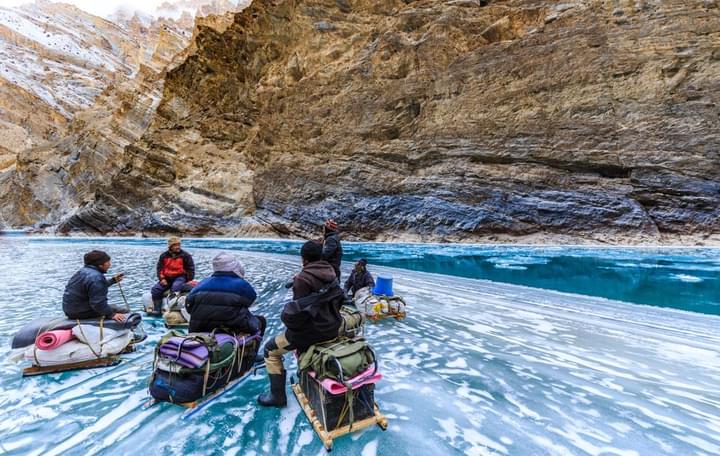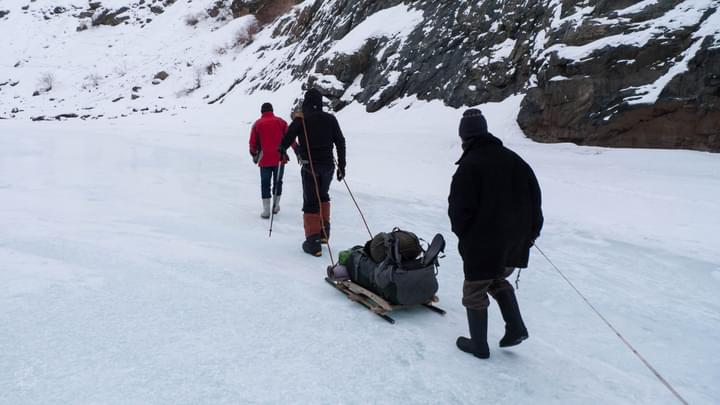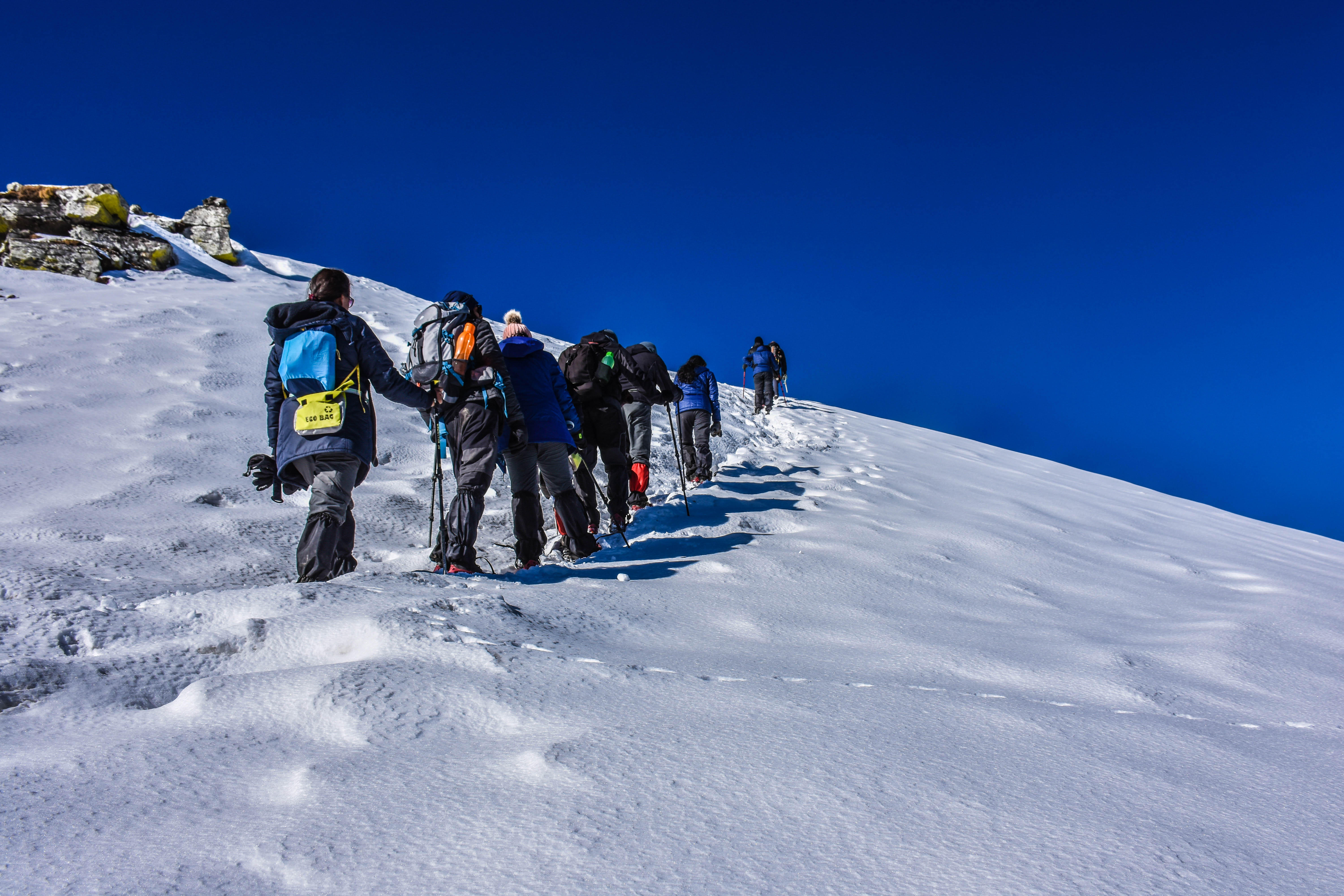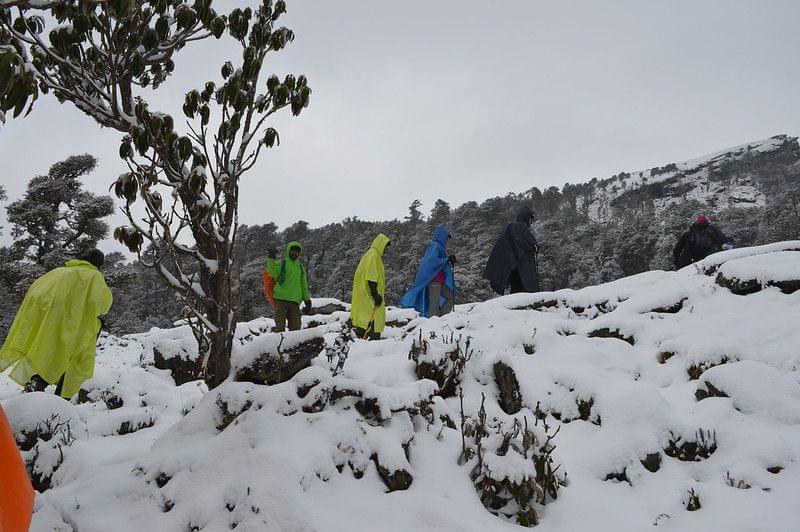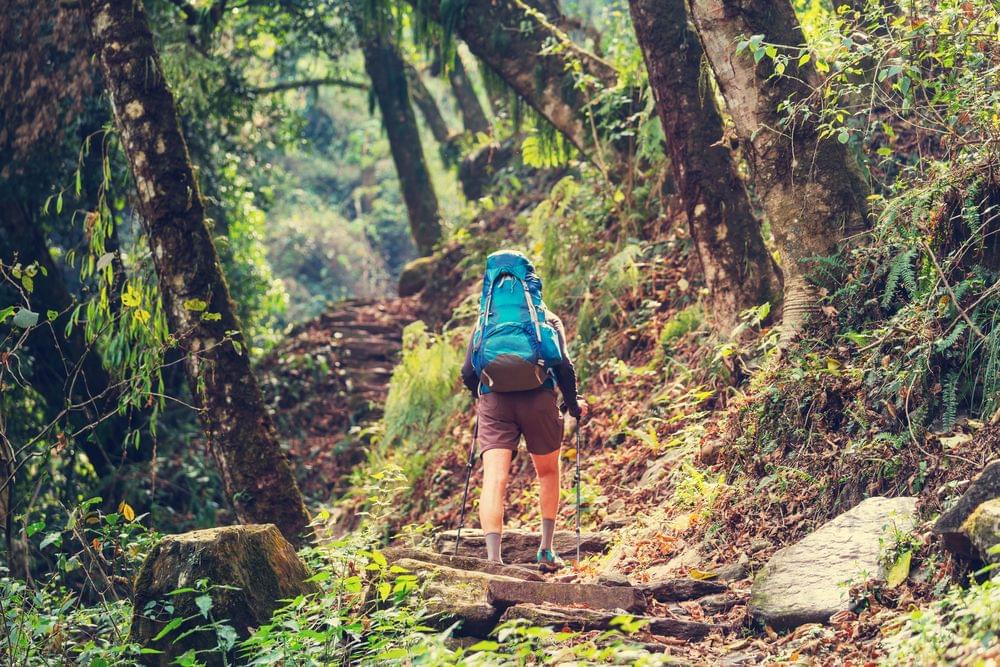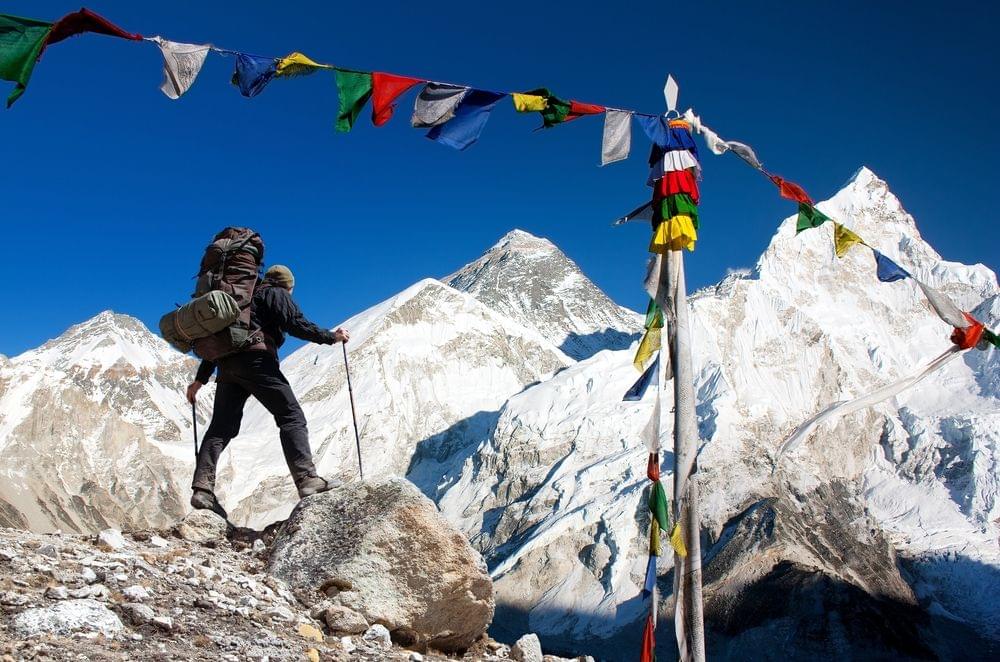Chadar Trek Overview
Book Chadar Trek Package
Quick Facts of Chadar Trek
- Maximum altitude: 11150 feet
- Grade: Difficult
- Duration: Nine days
- Trekking distance: 62 kilometers
- Trail type: One-way trail. The trek commences and ends at Shingra Koma.
- Rail head: No rail head
- Airport: Kushok Bakula Rimpochee Airport (Leh)
- Snow Season: January and February
- Service from: Leh Airport to Leh Airport (Transport included)
- Base camp: Leh
- Best season: Winter season (January and February)
- Region: Ladakh
Who can Participate:- Serious trekkers who are fond of experiencing freezing temperatures.- Should have a minimum age of 15 years.- People with enough stamina to cover a distance of five kilometers in just 30 minutes.- Has an experience of at least one high-altitude trek of 5000 meters or 16400 feet.- Should have the capacity to carry a 12 to 16 kg backpack.
Why to Go for Chadar Trek?
Short Itinerary for Chadar Trek
Chadar Trek Detailed Itinerary
Reach Leh
- The Chadar trek commences after you arrive at the Kushok Bakula Rimpochee Airport in Leh.
- On your way to your hotel on the outskirts of Leh, you will experience gorgeous snow-capped mountains that will definitely leave you awestruck with their striking beauty.
- It is advisable to keep your woolen caps and gloves handy as you may feel an immediate drop in temperature when you arrive at the Leh airport.
- After you reach Leh, you can rest for the day and acclimatize to the cold weather conditions.
- The weather in Leh will give you a taste of what it will be like when you go for the Chadar trek.
- In the evening time, you can go window shopping on the streets of Leh market to grab things that you would require in the trekking expedition.
- You are not allowed to start your trekking journey on the same day of your arrival because it is extremely necessary for your body to adapt to the cold weather condition as the temperature may drop even further when you start climbing towards the Zanskar River.
- Now, get back to your rooms and have a good night's sleep to revitalize your body for the trip.
Rest and Acclimatize in Leh
- Considering the health conditions of the trekkers and according to the new regulations, trekkers who are willing to go on the Chadar trek are required to acclimatize their bodies completely to the cold weather conditions in Leh for two days.
- In order to acclimatize, you can either spend the day visiting the nearby attractions of Leh or rest in a centrally-heated room at your hotel.
- Every trekker is advisable not to go to places with higher altitudes on this day.
- The second day gets completed by packing your travel backpack with all the essentials and rest for the day.
Undergo Medical Checkup in Leh
- The third day is the most significant day of the trek. This day decides whether your body is eligible for continuing the Chadar trek or not.
- For this, you need to wake up early in the morning and drive or walk to the Government Medical Camp.
- You must reach the location as early as possible because the tests get delayed due to the rush of tourists. It will not take more than three to four hours to complete all your checkup depending on the rush.
- After the tests, you must proceed further to finish any insurance formalities, wildlife permits, and other significant documents.
- By any chance, the tests state that you are unfit for the Chadar trek, you can take a physical wild card and select the ‘Flavor of winter Ladakh’ tour without any additional cost.
Move from Leh to Gyalpo via Chilling and Tilad do
- This is the actual day of your Chadar trek. On this day, you will head towards your first campsite in Shingra Koma through Chilling.
- The day will start with a drive from Leh that will let you spot some scenic attractions in Ladakh.
- On your way, you will come across plenty of remarkable sights, like Gurudwara Pathar Sahib, Magnetic Hill, and the convergence of the Indus and Zanskar river.
- After a short drive of 90 minutes along the Zanskar River, you will reach Chilling.
- It is the place where the car will drop you at the end of the road. From there, you will start your walk on the Zanskar river.
- Initially, it may be difficult for you to walk on the ice with your gumboots on as the sheet may be thin, but you will understand the ice patterns slowly and gradually.
- It is advisable to plant your foot and walking sheet on the ice to check the steadiness before moving on it wholeheartedly.
- You must also ensure that the weight of your backpack is not heavy so you can carry it yourself effortlessly.
- After a walking struggle of about one and a half hours, you will reach your first campsite at Gyalpo, where you will experience your first sub-zero temperature camping.
- Rest for an overnight sleep in Gyalpo.
Gyalpo to Tibb Cave
- Chadar trek is one of the treks where you will not be able to see altitudes in quick succession. But, when you slowly move to Tibb Cave from Gyalpo after five to six hours, you will find yourself rising at an altitude of 300 feet.
- After spending a chilling night in your tent at Gyalpo, you are required to have a sumptuous breakfast to regain energy for the further trekking expedition. A hot cup of tea will also revitalize your senses in this cold temperature.
- After breakfast, the trek will resume, and the next campsite is Tibb Cave.
- While trekking, you will come across plenty of attractive frozen waterfalls, but the emerald green water of the Zanskar river will keep on flowing all along the trail.
- Midway to Tibb Cave, you can have your lunch.
- Post lunch, you will continue your trek, where you will discover varied rock patterns that shine uniquely as the rays of the sun fall on them.
- Finally, the day ends when you reach the campsite at Tibb Cave which is completely covered with dry sand.
Tibb Cave to Nerak
- The destination of Day 6 will be Nerak, which is a 13 kilometers long trail that takes you to the exemplary landmark of the Chadar trek named the Frozen Waterfall. The Frozen Waterfall is one of the beautiful attractions that garner the interest of tourists from around the globe.
- You will be served with hot lunch on your way to Nerak.
- It is by far the coldest campsite where the temperature drops to -30 degrees Celsius at night. Hence, you must wear appropriate clothing to keep the chilling atmosphere at bay.
- Day 6 ends with reaching Nerak campsite, which is situated around 15 to 20 minutes from the Frozen Waterfall.
- If the trekkers reach the Nerak campsite on time, they can also pay a visit to the Nerak village.
- The day ends with an overnight sleep in the Nerak camp.
Nerak to Tibb Cave
- Day 7 will be the returning day of your Chadar trek. It is indeed your last chance to embrace and relive the moments on the Zanskar River near the Frozen Waterfall.
- Chadar trek is completely a unique experience in itself. The weather conditions are very unpredictable in this region. You may find that the layer of Chadar has completely vanished from where you have come. However, at the same time, you will find that a new layer has been formed in some other place. Thus, it is advisable to take back all the memories in your backpack before returning from the trek.
- Say goodbye to the locals and start your trek on your way back to the Tibb Cave.
- On your way back, you will find locals negotiating the conventional woolen Gonchas at the Chadar where the monks are returning to Leh from the monastery at Lingshed. You may also find the young students returning to school after their vacation in Leh. This sight of local people is heartwarming to see as they are surviving in such a cold climate yet keep a long smile on their faces.
- You can sign off for the day after reaching Tibb Cave.
Tibb Cave to Shingra Koma via Gyalpo and then to Leh
- On Day 8, it is time to go back home and you need to wake up early to cover a long distance from Tibb Cave to Shingra Koma.
- While moving down to Shingra Koma, you will discover high walls of mountains rising on the sides of the river that almost looks like a castle.
- You will also notice the steps and footprints of foxes, ibex, or snow leopards on the Chadar trek.
- If you are lucky, you may even spot snow leopards. But you must rest assured that someone will keep a watch on you all the time on your way back to Gyalpo.
- You will not get a chance to retrace the steps while going back as the way might have changed a lot. The layer of chadar has melted and become thin. You may also see the formation of rocks on your way down to Shingra Koma.
- After reaching Shingra Koma, you will be asked to board a bumpy ride back to Leh at around 6.30 pm in the evening.
- You can rest after the tiring day at Leh in the warm guest house and get ready for your way back home on the next day.
Depart from Leh
- Day 9 will officially be your last day of the Chadar trek as you move back to your home, taking all the memories of the trek with you.
- The day starts with a delicious breakfast, and then you can get ready for checkout from the guesthouse by packing all your belongings.
- Say goodbye to your guesthouse and reach the Leh airport, from where you can head towards your destinations further!
- Your Chadar trek experience ends here.
General Trivia About The Trek
- Chadar trek does not include any kind of ascending and descending paths similar to the other Himalayan treks as you will be walking on a frozen sheet of ice on the Zanskar river all the time.
- Although Himalayan waters are considered safe for drinking, the trekking experts advise purifying the water by boiling it with chlorine tablets during the trek.
- The trade route between Zanskar and Ladakh regions that has existed for more than 1000 years is known as ‘Khado Sanglam’ in the local dialect.
- Zanskar river freezes completely during the months of January and February to form a walkable path of ice.
- There must at least be a group of six to seven people to go on the Chadar trek with a maximum of 15 to 18 people.
- February is considered to be the toughest time to go on the Chadar trek as the fluctuating temperatures during the day and night can cause broken trails along the way.
- The temperature on the Chadar trek drops to as low as -30 degrees Celsius, and thin air keeps flattering your skin at every inch of your walk.
- Chadar trek is unique as it is a complete surprise package of slippery ice sheets, occasional cave stays, unusual campsites, and brisk-changing weather conditions.
- If you are lucky, you may spot an old snow leopard or other wildlife on your trekking expedition.
- Pictures of the beautiful frozen Nerak waterfall are surely a remarkable way to account for the memories.
Know Before You Go to Chadar Trek
When you are going on a trekking expedition, it is essential to keep the do's and don’ts in mind. These tips will help the trekkers stay connected with their fellow travelers and prevent them in case of an emergency situation. Here are some of the important tips that trekkers should consider on the Chadar frozen river trek:
- Inform your friends and family about the trek and give the number of your trekking organization to them so they can contact you in case of any emergency.
- Wear warm clothes at all times and carry stuff that can keep you warm at all times as the temperature may drop drastically and unexpectedly during your trek.
- Do not forget to carry your first aid kit and all the necessary medications as bruises and cuts are relatively common during treks and hikes.
- Keep yourself hydrated at all times. People are more likely to skip drinking water due to the cold climate.
- Walk actively and carefully as the sheet of ice may be slippery.
- Do not litter everywhere as it is strictly prohibited to throw plastic and biodegradable stuff on the trekking trails.
- Avoid contaminating the waterfalls while bathing with chemical soaps because villagers use this water for drinking purposes.
- Remain polite towards your trek leader and co-trekker at all times.
- Do not skip your meal under any circumstances.
- Always be together with your trekking group, and do not wander anywhere on your own.
- Ensure that you carry all the trekking essentials in your backpack.
- Follow the instructions given by the trekking leader to ensure safety and security at all times.
Basic Gear:- Backpack (50 to 60 liters) with appropriate shoulder straps and raincoat- 2 thermos flask water bottles of one liter each- Medical kit after consultation from the doctor- A walking stick- Snacks, like dry fruits, energy bars, electoral / ORS, and much more.
Clothes:
- 1 full sleeves non-cotton T-shirt
- 2 fleece T-shirts
- 1 fleece jacket
- 2 pairs of thermal inners (both upper and lower)
- 1 down feather or hollofil jacket
- 1 pair of fleece or wool gloves
- 1 pair of waterproof gloves
- 1 pair of waterproof jackets and pant
- 1 pair of Windstopper pant
Personal Utilities:
- Antibacterial powder
- Hand sanitizer
- Chapstick or Lip balm
- Moisturizer
- Quick dry towel
- Sunscreen cream
- Toilet paper and wipes
- Toothbrush and toothpaste
Hand Gears:
- 1 balaclava
- 1 head torch
- 1 neck-gaiters
- Dark sunglasses with side cover, UV protected (do not wear contact lenses)
- 1 woolen cap
Foot Gears:
- 6 pairs of cotton socks
- Gaiters (optional)
- Floaters or flip flops (optional)
- 1 pair of gumboots (it is advisable to buy them from Leh)
- 1 pair of trekking shoes (optional yet highly recommended)
- 6 pairs of woolen socks
Others:
- Chadar trek route map
- Sleeping bag
- Hot water bag
- Valid ID proofs (passport & driving license) and their copies
- 4 passport size photographs
By Air- The easiest way to travel to the starting point of the Chadar trek Ladakh is Kushok Bakula Rimpochee Airport located in Leh. This airport is situated about 4 kilometers from the city's center and receives daily flights from Delhi, Mumbai, Srinagar, Chandigarh, Jammu, and several other places in India. Even if you are traveling from beyond the geographical boundaries of India, you can take a connecting flight from Delhi, Mumbai, and Kolkata to Leh. Go Air, and Air India are some of the airlines that operate frequently on this route. Traveling to Leh by air is an amazing experience, and it makes for a wonderful start for the trekking expedition.
By Train- You can also board a train to Leh. The train used to travel to Leh is New Delhi Jammu Tawi Rajdhani Express, which travels from New Delhi to Jammu. After reaching Jammu, you can take a bus to Srinagar and then to Leh.
By Road- After you reach the Leh airport, you will be traveling through two road routes, namely the Manali-Leh highway and the Srinagar-Leh highway. The visitors will discover beautiful snow-clad mountains and gorgeous roads while driving their way to the hotel. If you are visiting this place in extremely cold conditions (i.e., between October and November), these routes remain closed due to heavy snowfalls. From the airport, your trekking authorities will take you to your hotel so you can relax and start your trek afresh.
- The best and the only time to go on the Chadar trek is during the winter season, i.e., when the Zanskar river freezes. These winter months of January and February are best suited to admire the natural beauty of the Himalayas that has been preserved for centuries.
- If you are thinking of which month to plan your itinerary for Chadar frozen river trek, it is advisable to do it during the month of February as the ice is the most stable at this time.
- With temperatures ranging between -5 and -25 degrees Celsius, trekkers feel that February is the toughest winter time for Chadar trek.
- The fluctuating temperatures during the day and night in the month of February makes the trekking experience even more difficult as you may encounter broken trails along the way.
- On your trekking expedition, Nerak is the coldest among all the campsites, where the temperature drops down to as low as -30 degrees Celsius at night. You may also get a chance to visit the Nerak Village if you manage to reach the waterfalls on your trek.
- The heavy snowfall of the Pensi La Pass creates a thick sheet of ice on the surface of the Zanskar river and cuts the place from the rest of Jammu and Kashmir.
- Even the locals wait for winters to come so they can create a walkable path of ice and go back home. Hence, the winter season, i.e., January and February are the best months to go on a Chadar trek with your friends.
You May Also Book
FAQ's of Chadar Lake Trek
How difficult is the Chadar Trek?
The Chadar trek is regarded to be one of the most difficult treks in India. It gives you a larger-than-life feeling with its extreme weather conditions amidst the natural surroundings. What makes the trek even more difficult is that trekkers are required to walk on the surface of the thick layer of a frozen river. Hence, a trekker should have enough stamina to cover a distance of five kilometers in just 30 minutes is a good fit for the Chadar trek Ladakh.
You can also check your body mass index (BMI) to find if your fitness level matches the difficulty of the trek. If your BMI is normal, you can plan your fitness regime for trekking. On the contrary, if your BMI is not normal, you are required to consult your trusted physician before adopting any fitness regime. Moreover, consultation from a medical practitioner is recommended if you are suffering from any chronic illness.
What are the best months to visit this trek?
The best months to visit the Chadar trek are between the first week of January to the second week of February. During these months, a thick sheet of ice gets formed on the Zanskar river, which makes a great trekking path for adventure lovers.
What is the minimum and maximum age limit of the Chadar trek?
The minimum age limit of the Chadar trek is 13 years, but children between 13 to 17 years of age should always be accompanied by their parents or guardians. For people above 60 years of age, you need to carry a detailed medical certificate that states you are perfectly fit for an adventurous activity like trekking.
What is the cellular network connectivity of the trek?
The cellular network connectivity of the trek is relatively nice upto Leh. But, it becomes difficult to find any network connectivity once you proceed to elevate on your trekking expedition to the Himalayas.
When will there be snow on this Chadar trek?
You will always find snow on this Chadar trek as the trek takes place during the months of January and February when the place experiences extreme snowfall.
What is the cost of the Chadar trek?
The cost of the Chadar trek starts from 17000 to 28000 per person. However, this cost may be subject to change if you may wish to rent a porter or mule. The hospitalization or emergency fees also need to be borne by the trekker apart from the general charges. Hence, you must get all the terms clear with your traveling authority before booking your expedition. On the contrary, if you book your trekking tickets online, you may avail yourself of the additional deals and discounts to make your trip cost-effective.
Is Chadar trek for beginners?
Chadar trek involves walking over a thick sheet of ice on the surface of the Zanskar river. This nine-day trek includes extreme weather conditions with snow all around. It becomes difficult to walk on ice because of the uneven formation. Surviving in the extreme temperatures of -30 degrees Celsius is a remarkable experience in itself. Hence, the Chadar trek is not for beginners as a beginner would not know the knick-knacks of handling the extreme situations of the trek.
What kinds of tents or sleeping bags will be provided to us on the trek?
On the Chadar trek, each trekker is provided with four-season tents and the sleeping bags are rated to prevent people from temperatures between -15 to -20 degrees Celsius.
Are there any toilet facilities on the trek?
No, there are no toilet facilities on the Chadar trek. You need to work in compliance with the rules and regulations of the villagers.
Is it safe for a solo woman traveler to travel in fixed departures?
Yes, it is completely safe for a solo woman traveler to travel in fixed departures. The trekking organization takes complete care of the safety and security of women in the group.
Will I get a certificate of trek completion?
Yes, you will get a certificate of Chadar trek completion once you return from your expedition. This certificate for trek completion will not be available if you return from the trek midway.
.png?w=auto&h=400)
